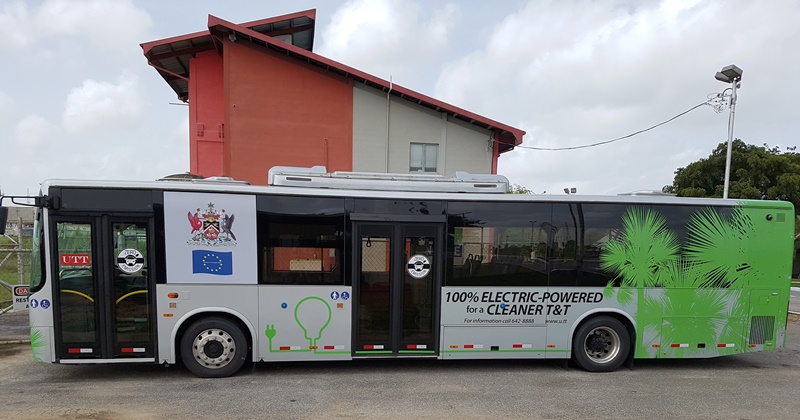

The University of Trinidad and Tobago (UTT) acquired an electric bus as part of a project carried out in partnership with the European Union (EU) and the national Ministry of Planning. It was the first all-electric vehicle in Trinidad and Tobago and the first electric bus in the entire Caribbean Community (CARICOM), according to UTT’s Dr. Curtis Boodoo, who led the bus project and who now chairs the Caribbean Sustainable Energy Roadmap and Strategy (C-SERMS) Electric Vehicles Work Group.
Since the 40-foot-long (12-meter) vehicle hit the road in 2016, it has received “nothing but praises,” Boodoo said. Made by one of the world’s largest electric bus manufacturers, the Chinese company BYD, the bus ferries staff and students between UTT’s 11 locations in Trinidad. (The university has a 12th campus on the island of Tobago.)
Being the first can have its complications. The licensing process took more than eight months, due to “archaic” laws that had to be amended and questions the Trinidad Transport Board had about an unfamiliar technology for a heavy vehicle, according to Boodoo.
“That bureaucracy really kept us back awhile,” he said in a telephone interview, adding that he doesn’t expect that anyone would have similar problems in the future, now that this type of heavy vehicle is familiar to the regulatory board.
The bus was no small investment; it cost about US$340,000 in 2015, 30 percent of which was covered by the EU and the remainder by UTT. The university invested in a training package and invited a range of other local stakeholders—including mechanics in the public transportation system and instructors from technical-vocational schools—to participate free of charge to learn how to service an electric vehicle. So far, operating costs have been minimal, Boodoo said, adding that the first routine service done on the bus was paid out of the university’s petty cash fund.
UTT has set up a Level 3, fast-charging station at its Point Lisas Campus—the only such station on the island, Boodoo said. Because no commercial charging stations yet exist, owners of electric and hybrid vehicles still need to plug in at home or work, using a portable Level 1 charger that can be plugged into a regular outlet but is very slow, or a fixed Level 2 charging station that is somewhat faster.
Boodoo estimates that there are still fewer than 200 all-electric vehicles on the road in Trinidad and Tobago and more than 2,000 hybrids, though he expects these numbers to grow considerably. “It’s just a matter of time before we see the adoption of electric vehicles in Trinidad,” he said, noting that the country has eliminated taxes and duties on imports of all fully-electric vehicles and small hybrids.
The Argument for Electric Vehicles
But do electric vehicles make sense in a country where the electric grid is powered by fossil fuels? Boodoo’s answer is a resounding yes.
“It’s still worth it, even if your grid is dirty,” he said, pointing out that electric engines are far more efficient than their internal combustion counterparts. He cited a 2017 “life cycle assessment” comparing greenhouse gas emissions for battery electric vehicles and conventional vehicles in several European countries. The study—done by Belgium’s VUB university, for a nongovernmental organization called Transportation & Environment—found that greenhouse gas emissions for electric vehicles were lower than for their conventional counterparts even in countries like Poland, which produces much of its electricity from hard coal.
The grid’s carbon intensity does play an important role. The study found that while an electric vehicle in Poland emits 25 percent less carbon dioxide over its lifetime, in Sweden, which has a cleaner grid, the reduction is 85 percent. Increasing the use of renewable energy is “the single most important opportunity” to improve the impact of battery electric vehicles, according to the study.
Another 2017 academic study, this one by the University of Michigan, calculated greenhouse gas emissions from battery electric vehicles across 143 countries, based on the mix of fuel sources used to generate electricity. It calculated a “fuel-economy equivalent” for each country, expressed in the number of miles per gallon (MPG) that a gasoline-powered vehicle would need to exceed to produce lower emissions than the electric vehicle.
In Trinidad and Tobago, which produces electricity from natural gas, that value is nearly 58 MPG, according to the study. In other words, a gasoline-powered vehicle would need to have a higher gas mileage than that to do better than an electric vehicle in terms of emissions.
Values from country to country vary widely, depending on the fuel mix used to produce electricity.
Coal and oil have the lowest fuel-economy equivalent values, at 29 MPG, followed by natural gas, geothermal, solar, nuclear, wind, and hydro—this last one the top performer by far, at a whopping 5,100 MPG equivalent. Among countries in the Americas, Paraguay had the best score in the study, followed by Costa Rica and Uruguay. (Calculations were based on 2015 data.)
In Trinidad and Tobago, meanwhile, UTT is putting plans in place to partially charge its electric bus using power generated by the university’s wind turbines. It estimates that the bus emits 9.9 tons less in carbon dioxide emissions per year than a similar diesel vehicle would.
On a personal level, the UTT’s Dr. Curtis Boodoo wishes he could say he drives an electric vehicle, but as is the case throughout the Caribbean, all vehicles tend to be considerably more expensive than in a large market such as the United States. “I only make those investments when I have to,” he said.
 View Map
View Map